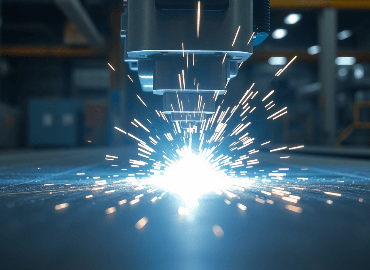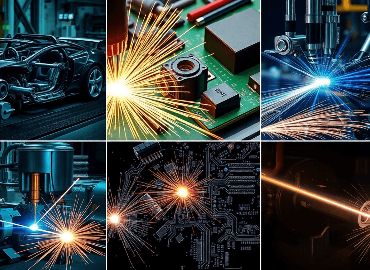Laser acrylic cutting is where precision meets technology, and the light unleashes its mighty fury. Beams of light carve masterpieces from acrylic sheets, with a wide range of applications to befit the industry's needs.
Laser cutting is a versatile technology that has revolutionized various industries, including manufacturing, design, and prototyping. One material that is frequently cut using laser technology is acrylic. Acrylic, also known as PMMA (Polymethyl methacrylate), is a popular thermoplastic due to its transparency, durability, and ease of fabrication. Laser Cutting acrylic offers numerous advantages, such as high precision, intricate detailing, and the ability to create complex designs with minimal material waste.
What is a Laser Cutting Acrylic?
Laser cutting acrylic refers to the process of using a laser beam to cut and shape acrylic sheets precisely. Acrylic laser cutting involves directing a focused laser beam onto the acrylic sheet, causing the material to melt, vaporize, or burn along the desired cutting path. This process allows for precise and intricate cuts, creating complex designs with minimal material waste.
Laser-cutting acrylic offers numerous benefits, including high precision, versatility, speed, efficiency, and clean cuts. It is preferred for signage, displays, prototyping, arts and crafts, and architectural design applications. This makes acrylic laser cutting your best choice if you want to produce intricate, polished pieces from a sturdy material.
It fully entails a device that produces laser light, which now burns or vaporizes the acrylic material to cut through it. This is a precise method of cutting an acrylic material with a specific design and creative technique that uses a laser to cut or engrave a particular material.
Basics of Laser Cutting Acrylic
Laser cutting acrylic involves using a high-powered laser beam to cut through acrylic sheets with precision and accuracy. Here are the basics of the laser cutting process for acrylic:
1. Material Selection and Machine Setup
Acrylic sheets come in various thicknesses and colors. Select the appropriate acrylic sheet based on your project requirements.
The laser cutting machine needs to be set up correctly for cutting acrylic. This includes adjusting the focus of the laser beam, setting the power and speed parameters, and ensuring proper ventilation to remove fumes.
2. Cutting Parameters and Process
Determine the specific cutting parameters based on the acrylic thickness and type. These parameters include laser power, cutting speed, and the number of passes needed to achieve the desired cut quality. Testing and optimizing these parameters is essential to ensure clean and precise cuts.
Once the Acrylic laser cutting machine is set up and safety measures are in place, the laser cutter will follow the design file, cutting the acrylic sheet along the specified path. The laser beam melts or vaporizes the acrylic material, creating a clean and precise cut. The machine's computer-controlled system ensures accuracy and repeatability.
3. Post-Processing
Inspect the cut edges for smoothness and quality after cutting. In some cases, additional post-processing steps like polishing or flame polishing might be required to achieve the desired finish.
Laser Cutting Acrylic Process
The process of laser cutting acrylic involves several steps to achieve precise and clean cuts. Proper training and experience in handling laser cutting equipment are essential to ensure safety and achieve optimal results when cutting acrylic.
1. Design Preparation
Create a digital design file using Computer-Aided Design (CAD) or vector-based graphic software. This design file should include the desired dimensions, shapes, and any intricate details that need to be cut from the acrylic sheet.
2. Material Selection
Choose the appropriate acrylic sheet for your project based on the required thickness, color, and transparency.
3. Machine Setup
Prepare the laser cutting machine for the acrylic cutting process. This includes calibrating and configuring the machine based on the specific acrylic material being used. Adjustments may include setting the focus, laser power, cutting speed, and other parameters to achieve optimal results.
4. Laser Cutting Parameters
Determine the specific cutting parameters based on the thickness and type of acrylic sheet. These parameters are crucial for achieving clean and accurate cuts. They include factors such as laser power, cutting speed, and the number of passes required for the desired cut quality. Testing and optimizing these parameters is important to ensure the best results.
5. Cutting Process
Once the setup and safety measures are complete, the laser-cutting process can begin. According to the design file, the laser beam is directed onto the acrylic sheet. The focused laser beam heats the acrylic material, causing it to melt, vaporize, or burn along the cutting path. The machine's computer-controlled system ensures accurate and precise cutting following the design file.
6. Post-Processing
Once the cutting process is finished, inspect the cut edges of the acrylic for smoothness and quality. In many cases, laser-cut acrylic edges are already smooth and do not require additional post-processing. However, you can perform further finishing processes like polishing or flame polishing to achieve a polished, glossy edge finish.
Factors Affecting the Acrylic Laser Cutting Process
1. Design Complexity
The complexity of the design, including the presence of intricate details and small features, can affect the laser-cutting process. Highly detailed designs may require slower cutting speeds and finer adjustments to achieve precise cuts without damaging delicate sections.
2. Focus
The focus of the laser beam determines the spot size and intensity. A properly focused beam ensures precise cutting and helps to achieve clean edges. The focus point should be adjusted based on the acrylic thickness to ensure the optimal balance between beam width and cutting depth.
3. Machine Maintenance
Proper calibration and maintenance of the laser cutting machine are crucial to ensure accurate and consistent cutting performance. Regularly checking and calibrating the machine's focus, alignment, and beam quality can help optimize the cutting process.
4. Laser Power
determines the laser beam's intensity and ability to cut through the acrylic material. The power level should be carefully adjusted based on the acrylic thickness. Insufficient power can result in incomplete cuts, while excessive power can cause excessive melting or burning, leading to rough or distorted edges.
5. Assist Gas
Assist gas, such as compressed air or nitrogen, can be used to blow away molten acrylic and debris from the cutting area during the laser cutting process. The choice of assist gas and its flow rate can affect the quality of the cuts and the removal of residues. It helps to prevent material re-adhesion and can enhance the overall cutting performance.
6. Material Properties
Different types and grades of acrylic may exhibit variations in their composition and characteristics. These variations can influence the laser-cutting process. It's essential to understand the acrylic's specific properties, such as its melting point, thermal conductivity, and sensitivity to laser energy. Adjustments in laser power, speed, and focus may be necessary to account for these variations.
7. Acrylic Thickness
The thickness of the acrylic sheet affects the laser-cutting process. Thicker sheets require higher laser power and slower cutting speeds to ensure complete and clean cuts. Conversely, thin sheets may require lower power and faster cutting speeds to prevent excessive melting or burning.
8. Cutting Speed
The cutting speed refers to the rate at which the laser beam moves along the cutting path. It is crucial to optimize the cutting speed to achieve clean cuts without causing excessive melting or charring. Higher cutting speeds may be suitable for thinner acrylic sheets, while slower speeds are often necessary for thicker materials.
Industry Applications of Laser Cutting on Acrylic
Laser-cutting acrylic finds applications in a wide range of industries due to its versatility, precision, and ability to create intricate designs. Here are some common industry applications of laser cutting on acrylic.
1. Signage and Displays
Laser-cut acrylic is widely used in the signage industry to create letters, logos, and signs. The acrylic's transparency allows for light transmission, making it an ideal material for illuminated signs and displays.
Examples
Many brands use custom business signs with laser-cut acrylic lettering and logos.
Event signage and banners with intricate designs and cutouts are used to give a classy and attractive look.
Point-of-sale displays with laser-cut acrylic components.
2. Point-of-Purchase Displays
Acrylic is widely used in point-of-purchase displays for retail environments. Laser cutting allows for the creation of intricate designs and shapes, enhancing the visual appeal of product displays.
Examples
Laser-cut acrylic parts for product prototypes, such as casings and enclosures.
Test models of mechanical components with laser-cut acrylic pieces.
3. Arts and Crafts
Artists and hobbyists utilize laser cutting on acrylic to create intricate designs for jewelry, ornaments, art pieces, and other decorative items. The precise cuts and fine detailing achievable through laser cutting enhance the artistic possibilities.
Examples
Intricate laser-cut acrylic sculptures or installations.
Laser-cut acrylic jewelry boxes or decorative frames.
4. Prototyping and Model Making
Laser-cutting acrylic is extensively used in prototyping and model-making processes across industries. It allows for the rapid production of precise and detailed prototypes, architectural models, product mock-ups, and more.
Examples
Laser-cut acrylic parts for product prototypes, such as casings and enclosures in goods.
Test models of mechanical components with laser-cut acrylic pieces.
5. Electronics and Electrical Enclosures
Acrylic is commonly used to create electronic components and device enclosures. Laser cutting enables the production of precise cutouts, holes, and slots for connectors, switches, and displays.
Examples
Laser-cut acrylic computer cases with precise ventilation and cable management holes.
Acrylic display cases with laser-cut acrylic for accessories of gadgets.
6. Automotive Industry
Laser-cut acrylic sheets find applications in the automotive industry for creating interior components, such as dashboard panels, instrument clusters, and lighting fixtures. Acrylic's durability and aesthetic appeal make it a suitable choice for automotive design.
Examples
In most car interiors, acrylic sheets are used for soft appeal near the dashboards and the music system.
7. Medical and Healthcare
Laser-cut acrylic is used in medical and healthcare applications to manufacture components like laboratory equipment, sample holders, surgical tools, and medical device enclosures. The precision and cleanliness of laser cutting make it ideal for medical settings.
Examples
Laser-cut acrylic manufactures surgical instruments like forceps, tweezers, and surgical clamps.
Laser-cutting acrylic is utilized to create precise components for medical implants and prosthetics.
8. Awards and Trophies
Laser-cut acrylic is popular for creating custom awards and trophies. Its transparency and ability to incorporate intricate designs make it an attractive material for recognition and commemorative items.
Examples
Laser-cut acrylic plaques with engraved text and logos.
Multi-layered acrylic trophies with intricate designs and details.
9. Architecture and Interior Design
Laser-cutting acrylic sheets enable the creation of decorative panels, room dividers, lighting fixtures, and customized interior design elements. Acrylic's versatility and wide range of colors make it suitable for various architectural and interior design applications.
Examples
Scale models of buildings and other constructions with laser-cut acrylic walls, windows, and details.
Metro City planning models with laser-cut acrylic landmarks and structures.
These are a few applications of the many industrial applications of laser cutting on acrylic. The versatility and precision of laser cutting make it a valuable tool for various sectors, enabling the production of high-quality, customized, and intricate acrylic components.'
Also Read, A Fiber Laser Machines Price Guide In India: Understanding the Investment
Advantages of Laser Cutting on Acrylic
1. Precision
Laser cutting provides exceptional precision, enabling the creation of intricate designs and complex shapes with tight tolerances. Precision laser cutting acrylic is widely used for industrial needs.
2. Smooth and Clean Cuts
Laser cutting produces clean edges without the need for additional finishing processes. The edges are smooth and often do not require post-processing.
3. Speed and Efficiency
Laser cutting is a fast and efficient process, allowing for quick production turnaround times, especially for small to medium-sized projects.
4. Versatility
The laser beam can cut through acrylic sheets of varying thicknesses, ranging from thin films to thick blocks, without the need for changing tools.
5. Minimal Material Waste
The laser beam's narrow kerf width minimizes material waste, optimizing material usage and reducing costs.
Disadvantages of Laser Cutting on Acrylic
While laser cutting on acrylic offers several advantages, there are also some disadvantages to consider. A few of them are listed below.
1. Material Limitations
Laser cutting is most effective on acrylic sheets of moderate thickness. Very thick or thin acrylic sheets may present challenges in achieving clean and precise cuts. Extremely thin acrylic sheets can warp or melt easily under the heat generated by the laser beam.
2. Material Edge Quality
Laser-cutting acrylic can sometimes result in melted or charring edges, especially if the cutting parameters are not properly optimized. This can affect the overall aesthetic appeal of the cut and may require additional post-processing or finishing to achieve the desired edge quality.
3. Material Waste
Laser-cutting acrylic generates material waste in the form of small particles and dust. This waste needs to be properly managed and disposed of to maintain a clean working environment and prevent health and safety hazards.
4. Potential for Material Damage
Inexperienced or improper use of laser cutting equipment can result in material damage, such as cracking or melting. This can occur if the laser power or speed is too high or the material must be securely held during the cutting process.
Despite these disadvantages, laser cutting on acrylic remains a popular and versatile method for precision cutting and shaping. With proper equipment, training, and optimization of cutting parameters, these limitations can be mitigated, and high-quality results can be achieved.
General Laser Processing Tips For Acrylic
Here are a few general laser processing tips for acrylic.
1. Support and Clamping
Securely support and clamp the acrylic sheet to prevent movement or vibration during cutting. This ensures accurate and consistent cuts and reduces the risk of material damage.
2. Clean Optics
Regularly clean the laser optics, including the lens and mirrors, to maintain optimal cutting performance. Dust or debris on the optics can reduce the beam quality and affect the quality of the cuts. Follow the manufacturer's instructions for proper cleaning techniques.
3. Proper Ventilation
Ensure proper ventilation in the laser cutting area to remove fumes and gases generated during the process. Acrylic fumes can be harmful, so it is important to have adequate ventilation or employ a fume extraction system to protect the operator's health and safety.
Tips for Laser Cutting on Acrylic
1. Optimize Laser Settings
Adjust the laser power, cutting speed, and frequency according to the acrylic thickness and type. Acrylic cutting with a laser may require higher power and slower cutting speeds, while thinner acrylic may require lower power and faster speeds. Experiment with different settings to find the right balance for clean cuts.
2. Ventilation
Provide proper ventilation in the laser cutting area to remove fumes and gases generated during the cutting process. Acrylic fumes can be hazardous, so it is important to have adequate ventilation or employ a fume extraction system to protect the operator's health and safety.
3. Clean Optics
Regularly clean the laser optics, including the lens and mirrors, to maintain optimal cutting performance. Dust or debris on the optics can scatter or absorb the laser beam, reducing cutting quality. Follow the manufacturer's instructions for proper cleaning procedures.
List of Laser Cutting Machines on Acrylic
1. Universal Laser Systems
Universal Laser Systems offers laser-cutting machines known for their versatility and precision. Models like the VLS and PLS series are commonly used to cut acrylic. The VLS6.60 and PLS6.150D are examples of popular models for acrylic cutting.
2. GCC LaserPro
GCC LaserPro provides laser cutting machines designed for various applications, including acrylic cutting. Models like the Spirit series and X series are well-suited for acrylic cutting. The GCC LaserPro Spirit GLS and X380 are commonly used for cutting acrylic.
3. Boss Laser
Boss Laser offers laser-cutting machines known for their affordability and cutting performance. Their models, such as the LS-1416 and LS-3655, are popular choices for Acrylic laser cutting technology.
Laser Technologies Pvt Ltd has evolved as a leading brand by delivering services with our services across various industries. In Laser Cutting Acrylic, we have top-notch equipment and facilities to provide the best to our customers.






